文学术语1
- 格式:doc
- 大小:31.50 KB
- 文档页数:3
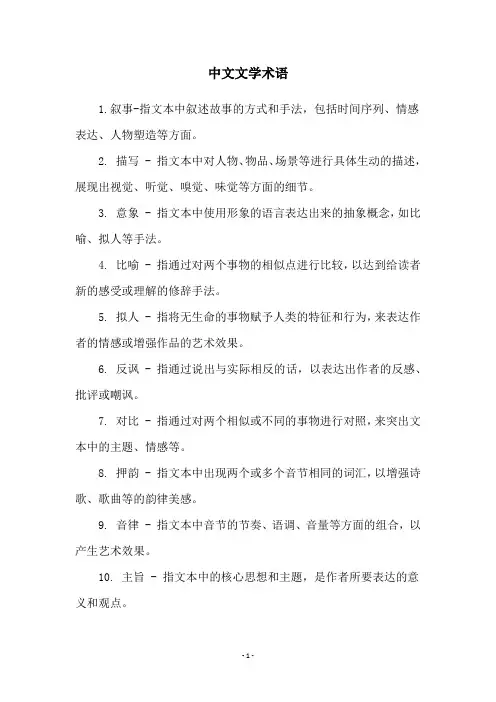
中文文学术语
1.叙事-指文本中叙述故事的方式和手法,包括时间序列、情感表达、人物塑造等方面。
2. 描写 - 指文本中对人物、物品、场景等进行具体生动的描述,展现出视觉、听觉、嗅觉、味觉等方面的细节。
3. 意象 - 指文本中使用形象的语言表达出来的抽象概念,如比喻、拟人等手法。
4. 比喻 - 指通过对两个事物的相似点进行比较,以达到给读者新的感受或理解的修辞手法。
5. 拟人 - 指将无生命的事物赋予人类的特征和行为,来表达作者的情感或增强作品的艺术效果。
6. 反讽 - 指通过说出与实际相反的话,以表达出作者的反感、批评或嘲讽。
7. 对比 - 指通过对两个相似或不同的事物进行对照,来突出文本中的主题、情感等。
8. 押韵 - 指文本中出现两个或多个音节相同的词汇,以增强诗歌、歌曲等的韵律美感。
9. 音律 - 指文本中音节的节奏、语调、音量等方面的组合,以产生艺术效果。
10. 主旨 - 指文本中的核心思想和主题,是作者所要表达的意义和观点。
- 1 -。
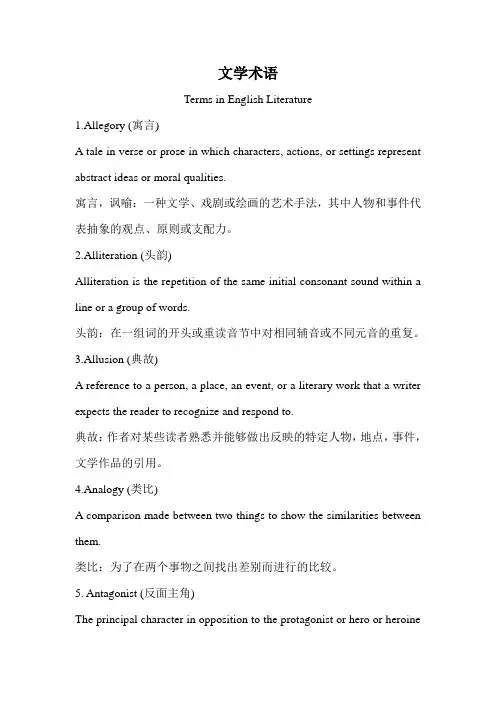
文学术语Terms in English Literature1.Allegory (寓言)A tale in verse or prose in which characters, actions, or settings represent abstract ideas or moral qualities.寓言,讽喻:一种文学、戏剧或绘画的艺术手法,其中人物和事件代表抽象的观点、原则或支配力。
2.Alliteration (头韵)Alliteration is the repetition of the same initial consonant sound within a line or a group of words.头韵:在一组词的开头或重读音节中对相同辅音或不同元音的重复。
3.Allusion (典故)A reference to a person, a place, an event, or a literary work that a writer expects the reader to recognize and respond to.典故:作者对某些读者熟悉并能够做出反映的特定人物,地点,事件,文学作品的引用。
4.Analogy (类比)A comparison made between two things to show the similarities between them.类比:为了在两个事物之间找出差别而进行的比较。
5. Antagonist (反面主角)The principal character in opposition to the protagonist or hero or heroineof a narrative or drama.反面主角:叙事文学或戏剧中与男女主人公或英雄相对立的主要人物。
6. Antithesis (对仗)The balancing of two contrasting ideas, words, or sentences.对仗:两组相对的思想,言辞,词句的平衡。
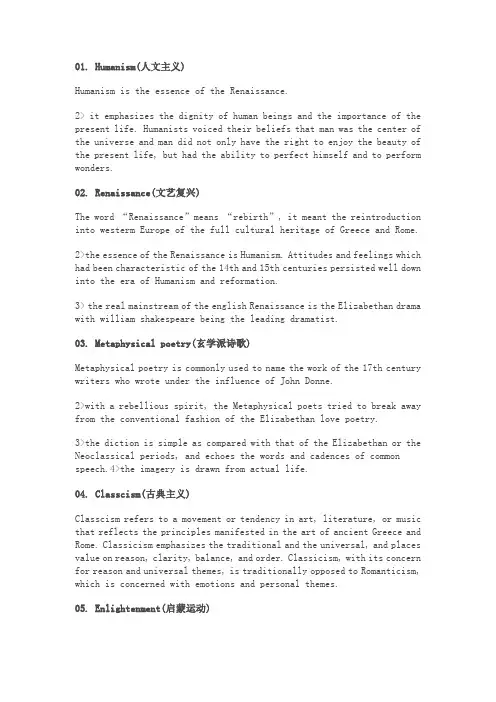
01. Humanism(人文主义)Humanism is the essence of the Renaissance.2> it emphasizes the dignity of human beings and the importance of the present life. Humanists voiced their beliefs that man was the center of the universe and man did not only have the right to enjoy the beauty of the present life, but had the ability to perfect himself and to perform wonders.02. Renaissance(文艺复兴)The word “Renaissance”means “rebirth”, it meant the reintroduction into westerm Europe of the full cultural heritage of Greece and Rome.2>the essence of the Renaissance is Humanism. Attitudes and feelings which had been characteristic of the 14th and 15th centuries persisted well down into the era of Humanism and reformation.3> the real mainstream of the english Renaissance is the Elizabethan drama with william shakespeare being the leading dramatist.03. Metaphysical poetry(玄学派诗歌)Metaphysical poetry is commonly used to name the work of the 17th century writers who wrote under the influence of John Donne.2>with a rebellious spirit, the Metaphysical poets tried to break away from the conventional fashion of the Elizabethan love poetry.3>the diction is simple as compared with that of the Elizabethan or the Neoclassical periods, and echoes the words and cadences of common speech.4>the imagery is drawn from actual life.04. Classcism(古典主义)Classcism refers to a movement or tendency in art, literature, or music that reflects the principles manifested in the art of ancient Greece and Rome. Classicism emphasizes the traditional and the universal, and places value on reason, clarity, balance, and order. Classicism, with its concern for reason and universal themes, is traditionally opposed to Romanticism, which is concerned with emotions and personal themes.05. Enlightenment(启蒙运动)Enlightenment movement was a progressive philosophical and artistic movement which flourished in france and swept through western Europe in the 18th century.2> the movement was a furtherance of the Renaissance from 14th century to the mid-17th century.3>its purpose was to enlighten the whole world with the light of modern philosophical and artistic ideas.4>it celebrated reason or rationality, equality and science. It advocated universal education.5>famous among the great enlighteners in england were those great writers like Alexander pope. Jonathan swift.etc.06.Neoclassicism(新古典主义)In the field of literature, the enlightenment movement brought about a revival of interest in the old classical works.2>this tendency is known as neoclassicism. The Neoclassicists held that forms of literature were to be modeled after the classical works of the ancient Greek and Roman writers such as Homer and Virgil and those of the contemporary French ones.3> they believed that the artistic ideals should be order, logic, restrained emotion and accuracy, and that literature should be judged in terms of its service to humanity.07. The Graveyard School(墓地派诗歌)The Graveyard School refers to a school of poets of the 18th century whose poems are mostly devoted to a sentimental lamentation or meditation on life. Past and present, with death and graveyard as themes.2>Thomas Gray is considered to be the leading figure of this school and his Elegy written in a country churchyard is its most representative work.08. Romanticism(浪漫主义)1>In the mid-18th century, a new literary movement called romanticism came to Europe and then to England.2>It was characterized by a strong protest against the bondage of neoclassicism, which emphasized reason, order and elegant wit. Instead, romanticism gave primary concern to passion, emotion, and natural beauty.3>In the history of literature. Romanticism is generally regarded as the thought that designates a literary and philosophical theory which tends to see the individual as the very center of all life and experience. 4> The English romantic period is an age of poetry which prevailed in England from 1798 to 1837. The major romantic poets include Wordsworth, Byron and Shelley.09. Byronic Hero(拜伦式英雄)Byronic hero refers to a proud, mysterious rebel figure of noble origin.2> with immense superiority in his passions and powers, this Byronic Hero would carry on his shoulders the burden of righting all the wrongs in a corrupt society. And would rise single-handedly against any kind of tyrannical rules either in government, in religion, or in moral principles with unconquerable wills and inexhaustible energies.3> Byron’s chief contr ibution to English literature is his creation of the “Byronic Hero”10. Critical Realism(批判现实主义)Critical Realism is a term applied to the realistic fiction in the late 19th and early 20th centuries.2> It means the tendency of writers and intellectuals in the period between 1875 and 1920 to apply the methods of realistic fiction to the criticism of society and the examination of social issues.3> Realist writers were all concerned about the fate of the common people and described what was faithful to reality.4> Charles Dickens is the most important critical realist.11. Aestheticism(美学主义)The basic theory of the Aesthetic movement--- “art for art’s sake” was set forth by a French poet, Theophile Gautier, the first Englishman who wrote about the theory of aestheticism was Walter Pater.2> aestheticism places art above life, and holds that life should imitate art, not art imitate life.3> According to the aesthetes, all artistic creation is absolutely subjective as opposed to objective. Art should be free from any influence of egoism. Only when art is for art’s sake, can it be immortal. They believed that art should be unconcerned with controversial issues, such as politics and morality, and that it should be restricted to contributing beauty in a highly polished style.4> This is one of the reactions against the materialism and commercialism of the Victorian industrial era, as well as a reaction against the Victorian convention of art for morality’s sake, or art for money’s sake.美学运动的基本原则”为艺术而艺术”最初由法国诗人西奥费尔.高缔尔提出,英国运用该美学理论的第一人是沃尔特.佩特.美学主义崇尚艺术高于生活,认为生活应模仿艺术,而不是艺术模仿生活.在美学主义看来,所有的艺术创作都是绝对主观而非客观的产物.艺术不应受任何功利的影响,只有当艺术为艺术而创作时,艺术才能成为不朽之作.他们还认为艺术不应只关注一些热点话题如政治和道德问题,艺术应着力于以华丽的风格张扬美.这是对维多利亚工业发展时期物质崇拜的一种回应,也是向艺术为道德或为金钱而服务的维多利亚传统的挑战.12.The Victorian period(维多利亚时期)In this period, the novel became the most widely read and the most vital and challenging expression of progressive thought. While sticking to the principle of faithful representation of the 18th century realist novel, novelists in this period carried their duty forward to criticism of the society and the defense of the mass.2> although writing from different points of view and with different techniques, they shared one thing in common, that is, they were all concerned about the fate of the common people. They were angry with the inhuman social institutions, the decaying social morality as represented by the money-worship and Utilitarianism, and the widespread misery, poverty and injustice.3>their truthful picture of people’s life and bitter and strong criticism of the society had done much in awakening the public consciousness to the social problems and in the actual improvement of the society.4> Charles Dickens is the leading figure of the Victorian period.13. Modernism(现代主义)Modernism is comprehensive but vague term for a movement , which begin in the late 19th century and which has had a wide influence internationally during much of the 20th century.2> modernism takes the irrational philosophy and the theory ofpsycho-analysis as its theoretical case.3> the term pertains to all the creative arts. Especially poetry, fiction, drama, painting, music and architecture.4> in England from early in the 20th century and during the 1920s and 1930s, in America from shortly before the first world war and on during the inter-war period, modernist tendencies were at their most active and fruitful.5>as far as literature is concerned, Modernism reveals a breaking away from established rules, traditions and conventions, the fresh ways of lo oking at man’s position and function in the universe and many experiments in form and style. It is particularly concerned with language and how to use it and with writing itself.14. Stream of consciousness(意识流)(or interior monologue)In literary criticism, Stream of consciousness denotes a literary technique which seeks to describe an individual’s point of view by giving the written equivalent of the character’s thought processes. Stream of consciousness writing is strongly associated with the modernist movement. Its introduction in the literary context, transferred from psychology, hhhyis attributed to May Sinclair. Stream of consciousness writing is usually regarded as a special form of interior monologue and is characterized by associative leaps in syntax and punctuation that can make the prose difficult to follow, tracing as they do a character’s fragmentary thoughts and sensory feelings. Famous writers to employ this technique in the English language include James Joyce and William Faulkner.学术界认为意识流是一种通过直接描述人物思维过程来寻求个人视角的文学写作技巧。
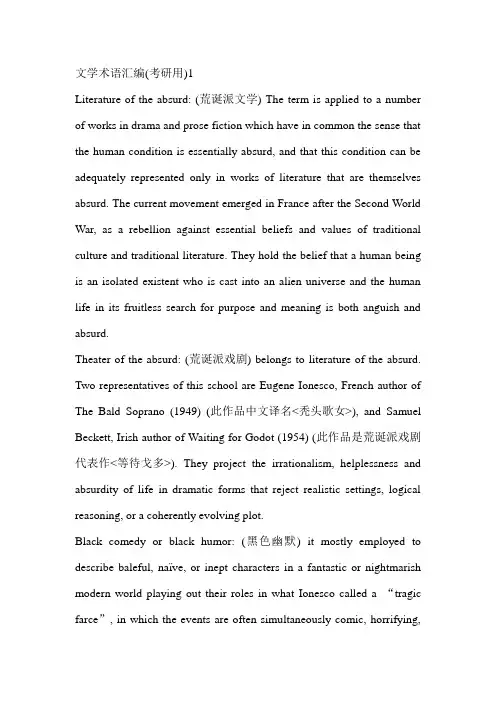
文学术语汇编(考研用)1Literature of the absurd: (荒诞派文学) The term is applied to a number of works in drama and prose fiction which have in common the sense that the human condition is essentially absurd, and that this condition can be adequately represented only in works of literature that are themselves absurd. The current movement emerged in France after the Second World War, as a rebellion against essential beliefs and values of traditional culture and traditional literature. They hold the belief that a human being is an isolated existent who is cast into an alien universe and the human life in its fruitless search for purpose and meaning is both anguish and absurd.Theater of the absurd: (荒诞派戏剧) belongs to literature of the absurd. Two representatives of this school are Eugene Ionesco, French author of The Bald Soprano (1949) (此作品中文译名<秃头歌女>), and Samuel Beckett, Irish author of Waiting for Godot (1954) (此作品是荒诞派戏剧代表作<等待戈多>). They project the irrationalism, helplessness and absurdity of life in dramatic forms that reject realistic settings, logical reasoning, or a coherently evolving plot.Black comedy or black humor: (黑色幽默) it mostly employed to describe baleful, naïve, or inept characters in a fantastic or nightmarish modern world playing out their roles in what Ionesco called a “tragic farce”, in which the events are often simultaneously comic, horrifying,and absurd. Joseph Heller’s Catch-22 (美国著名作家约瑟夫海勒<二十二条军规>) can be taken as an example of the employment of this technique.文学术语汇编24. Aestheticism or the Aesthetic Movement(唯美主义): it began to prevail in Europe at the middle of the 19th century. The theory of “art for art’s sake”was first put forward by some French artists. They declared that art should serve no religious, moral or social purpose. The two most important representatives of aestheticists in English literature are Walt Pater and Oscar Wilde.5. Allegory(寓言): a tale in verse or prose in which characters, actions, or settings represent abstract ideas or moral qualities, such as John Bunyan’s The Pilgrim’s Progress. An allegory is a story with two meanings, a literal meaning and a symbolic meaning.6. Fable(寓言): is a short narrative, in prose or verse, that exemplifies an abstract moral thesis or principle of human behavior. Most common is the beast fable, in which animals talk and act like the human types they represent. The fables in Western cultures derive mainly from the stories attributed to Aesop, a Greek slave of the sixth century B. C.7. Parable(寓言): is a very short narrative about human beings presented so as to stress analogy with a general lesson that the narrator is trying tobring home to his audience. For example, the Bible contains lots of parables employed by Jesus Christ to make his flock understand his preach.(注意以上三个词在汉语中都翻译成语言,但是内涵并不相同,不要搞混)8. Alliteration(头韵): the repetition of the initial consonant sounds. In Old English alliterative meter, alliteration is the principal organizing device of the verse line, such as in Beowulf.9. Consonance is the repetition of a sequence of two or more consonants but with a change in the intervening vowel, such as “live and love”.10. Assonance is the repetition of identical or similar vowel, especially in stressed syllables, in a sequence of nea rby words, such as “child of silence”.11. Allusion (典故)is a reference without explicit identification, to a literary or historical person, place, or event, or to another literary work or passage. Most literary allusions are intended to be recognized by the generally educated readers of the aut hor’s time, b ut some are aimed at a special group.12. Ambiguity(复义性): Since William Empson(燕卜荪)published Seven Types of Ambiguity(《复义七型》), the term has been widely used in criticism to identify a deliberate poetic device: the use of a single word or expression to signify two or more distinct references, or to express twoor more diverse attitudes or feeling.文学术语汇编313. Antihero(反英雄):the chief character in a modern novel or play whose character is totally different from the traditional heroes. Instead of manifesting largeness, dignity, power, or heroism, the antihero is petty, passive, ineffectual or dishonest. For ex ample, the heroine of Defoe’s Moll Flanders is a thief and a prostitute.14. Antithesis(对照):(a figure of speech) An antithesis is often expressed in a balanced sentence, that is, a sentence in which identical or similar syntactic structure is used to express contrasting ideas. For example, “Marriage has many pains, but celibacy(独身生活)has no pleasures.”by Samuel Johnson obviously employs antithesis.15. Archaism(拟古):the literary use of words and expressions that have become obsolete in the common speech of an era. For example, the translators of the King James V ersion of Bible gave weight and dignity to their prose by employing archaism.16. Atmosphere(氛围): the prevailing mood or feeling of a literary work. Atmosphere is often developed, at least in part, through descriptions of setting. Such descriptions help to create an emotional climate to establish the reader’s expectations and attitudes.文学术语汇编417. Ballad(民谣):it is a song, transmitted orally, which tells a story. It originated and was communicated orally among illiterate or only partly literate people. It exists in many variant forms. The most common stanza form, called ballad stanza is a quatrain in alternate four- and three-stress lines; usually only the second and fourth lines rhyme. Although many traditional ballads probably originated in the late Middle Age, they were not collected and printed until the eighteenth century.18. Climax:as a rhetorical device it means an ascending sequence of importance. As a literary term, it can also refer to the point of greatest intensity, interest, or suspense in a story’s turning point. The action leading to the climax and the simultaneous increase of tension in the plot are known as the rising action. All action after the climax is referred to as the falling action, or resolution. The term crisis is sometimes used interchangeably with climax.19. Anticlimax(突降):it denotes a writer’s deliberate drop from the serious and elevated to the trivial and lowly, in order to achieve a comic or satiric effect. It is a rhetorical device in English.20. Beat Generation(垮掉一代):it refers to a loose-knit group of poets and novelists, writing in the second half of the 1950s and early 1960s, who shared a set of social attitudes –antiestablishment, antipolitical, anti-intellectual, opposed to the prevailing cultural, literary, and moral values, and in favor of unfettered self-realization and self-expression.Representatives of the group include Allen Ginsberg, Jack Kerouac and William Burroughs. And most famous literary creations produced by this group should be Allen Ginsberg’s long poem Howl and Jack Kerouac’s On the Road.文学术语汇编521. Biography(传记):a detailed account of a person’s life written by another person, such as Samuel Johnson’s Lives of the English Poets and James Boswell’s Life of Samuel Johnson.22. Autobiography(自传):a person’s account of his or her own life, such as Benjamin Franklin’s autobiography.24. A parody(模仿)imitates the serious manner and characteristic features of a particular literary work, or the distinctive style of a particular author, or the typical stylistic and other features of a serious literary genre, and deflates the original by applying the imitation to a lowly or comically inappropriate subject.第23个应该是blank verse但系统总说含有不允许的关键字,所以一直发不上来,很郁闷,我把目前编好的一起发到公开邮箱去,大家到那里下载。
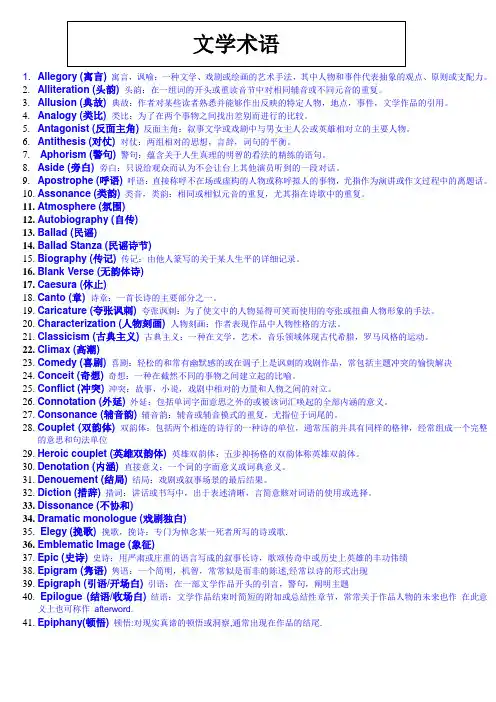
1. Allegory (寓言)寓言,讽喻:一种文学、戏剧或绘画的艺术手法,其中人物和事件代表抽象的观点、原则或支配力。
2.Alliteration (头韵) 头韵:在一组词的开头或重读音节中对相同辅音或不同元音的重复。
3.Allusion (典故) 典故:作者对某些读者熟悉并能够作出反映的特定人物,地点,事件,文学作品的引用。
4.Analogy (类比) 类比:为了在两个事物之间找出差别而进行的比较。
5.Antagonist (反面主角)反面主角:叙事文学或戏剧中与男女主人公或英雄相对立的主要人物。
6.Antithesis (对仗) 对仗:两组相对的思想,言辞,词句的平衡。
7. Aphorism (警句)警句:蕴含关于人生真理的明智的看法的精练的语句。
8.Aside (旁白) 旁白:只说给观众而认为不会让台上其他演员听到的一段对话。
9.Apostrophe (呼语)呼语:直接称呼不在场或虚构的人物或称呼拟人的事物,尤指作为演讲或作文过程中的离题话。
10.Assonance (类韵)类音,类韵:相同或相似元音的重复,尤其指在诗歌中的重复。
11.Atmosphere (氛围)12.Autobiography (自传)13.Ballad (民谣)14.Ballad Stanza (民谣诗节)15.Biography (传记)传记:由他人篆写的关于某人生平的详细记录。
16.Blank Verse (无韵体诗)17.Caesura (休止)18.Canto (章) 诗章:一首长诗的主要部分之一。
19.Caricature (夸张讽刺) 夸张讽刺:为了使文中的人物显得可笑而使用的夸张或扭曲人物形象的手法。
20.Characterization (人物刻画) 人物刻画:作者表现作品中人物性格的方法。
21.Classicism (古典主义) 古典主义:一种在文学,艺术,音乐领域体现古代希腊,罗马风格的运动。
22.Climax (高潮)edy (喜剧)喜剧:轻松的和常有幽默感的或在调子上是讽刺的戏剧作品,常包括主题冲突的愉快解决24.Conceit (奇想)奇想:一种在截然不同的事物之间建立起的比喻。
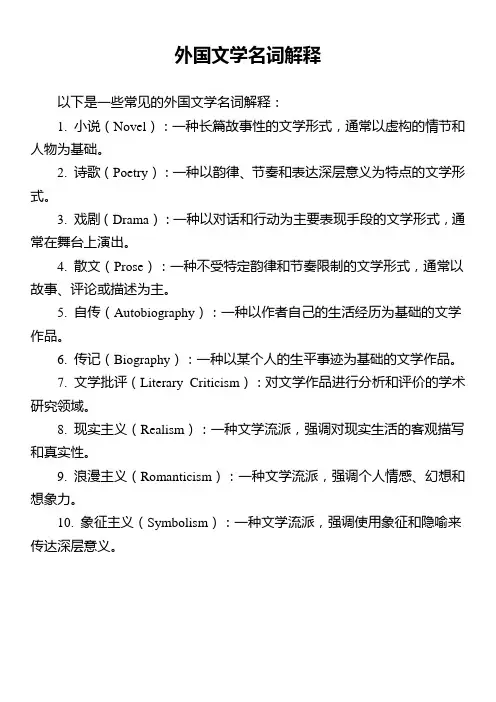
外国文学名词解释
以下是一些常见的外国文学名词解释:
1. 小说(Novel):一种长篇故事性的文学形式,通常以虚构的情节和人物为基础。
2. 诗歌(Poetry):一种以韵律、节奏和表达深层意义为特点的文学形式。
3. 戏剧(Drama):一种以对话和行动为主要表现手段的文学形式,通常在舞台上演出。
4. 散文(Prose):一种不受特定韵律和节奏限制的文学形式,通常以故事、评论或描述为主。
5. 自传(Autobiography):一种以作者自己的生活经历为基础的文学作品。
6. 传记(Biography):一种以某个人的生平事迹为基础的文学作品。
7. 文学批评(Literary Criticism):对文学作品进行分析和评价的学术研究领域。
8. 现实主义(Realism):一种文学流派,强调对现实生活的客观描写和真实性。
9. 浪漫主义(Romanticism):一种文学流派,强调个人情感、幻想和想象力。
10. 象征主义(Symbolism):一种文学流派,强调使用象征和隐喻来传达深层意义。
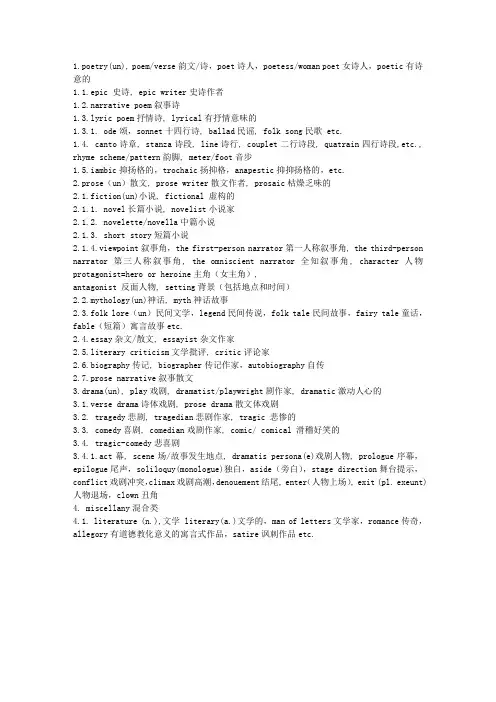
1.poetry(un), poem/verse韵文/诗,poet诗人,poetess/woman poet女诗人,poetic有诗意的1.1.epic 史诗, epic writer史诗作者1.2.narrative poem叙事诗1.3.lyric poem抒情诗, lyrical有抒情意味的1.3.1. ode颂,sonnet十四行诗, ballad民谣, folk song民歌 etc.1.4. canto诗章, stanza诗段, line诗行, couplet二行诗段, quatrain四行诗段,etc., rhyme scheme/pattern韵脚, meter/foot音步1.5.iambic抑扬格的,trochaic扬抑格,anapestic抑抑扬格的,etc.2.prose(un)散文, prose writer散文作者, prosaic枯燥乏味的2.1.fiction(un)小说, fictional 虚构的2.1.1. novel长篇小说, novelist小说家2.1.2. novelette/novella中篇小说2.1.3. short story短篇小说2.1.4.viewpoint叙事角,the first-person narrator第一人称叙事角, the third-person narrator第三人称叙事角, the omniscient narrator全知叙事角, character人物protagonist=hero or heroine主角(女主角),antagonist 反面人物, setting背景(包括地点和时间)2.2.mythology(un)神话, myth神话故事2.3.folk lore(un)民间文学,legend民间传说,folk tale民间故事,fairy tale童话,fable(短篇)寓言故事etc.2.4.essay杂文/散文, essayist杂文作家2.5.literary criticism文学批评, critic评论家2.6.biography传记, biographer传记作家,autobiography自传2.7.prose narrative叙事散文3.drama(un), play戏剧, dramatist/playwright剧作家, dramatic激动人心的3.1.verse drama诗体戏剧, prose drama散文体戏剧3.2. tragedy悲剧, tragedian悲剧作家, tragic 悲惨的3.3. comedy喜剧, comedian戏剧作家, comic/ comical 滑稽好笑的3.4. tragic-comedy悲喜剧3.4.1.act幕, scene场/故事发生地点, dramatis persona(e)戏剧人物, prologue序幕,epilogue尾声,soliloquy(monologue)独白,aside(旁白),stage direction舞台提示,conflict戏剧冲突,climax戏剧高潮,denouement结尾, enter(人物上场), exit (pl. exeunt)人物退场,clown丑角4. miscellany混合类4.1. literature (n.),文学 literary(a.)文学的,man of letters文学家,romance传奇,allegory有道德教化意义的寓言式作品,satire讽刺作品etc.。

中国文学术语集
以下是一些中国文学术语的集合:
1. 诗歌体裁:
- 诗:表达情感、描绘景物和抒发思想的文学形式。
- 词:以短小精悍的形式表达情感的文学形式。
- 曲:以歌唱为主的文学形式。
- 赋:以描写或抒发感情为主的文学形式。
2. 修辞手法:
- 比喻:用一种事物来比喻另一种事物,以增强表达的艺术性和形象性。
- 拟人:赋予非人物以人的特征和行为,增加情感共鸣。
- 夸张:夸大事物的特征或程度,以增强表达的效果。
- 排比:通过列举相同结构的词语或短语来加强表达的力度。
3. 修辞格:
- 对偶:用相同或相似的词语、短语或句子结构来表达对立或相反的意思。
- 反问:用疑问句的形式来表达肯定或否定的意思。
- 押韵:在诗歌中使用相同或相似的音韵来增加韵律感。
4. 现象:
- 平仄:指汉字的声调高低变化。
- 押韵:在诗歌中使用相同或相似的音韵来增加韵律感。
- 韵律:诗歌中的节奏和音乐感。
5. 文学流派:
- 唐诗:盛行于唐朝的诗歌形式,以七言绝句为主要形式。
- 宋词:盛行于宋朝的短小精悍的诗歌形式。
- 元曲:盛行于元朝的戏剧形式,以曲子和对白相结合的形式。
这只是一些中国文学术语的集合,还有许多其他的术语和概念,用于描述和分析中国文学作品和文学创作的特点和风格。
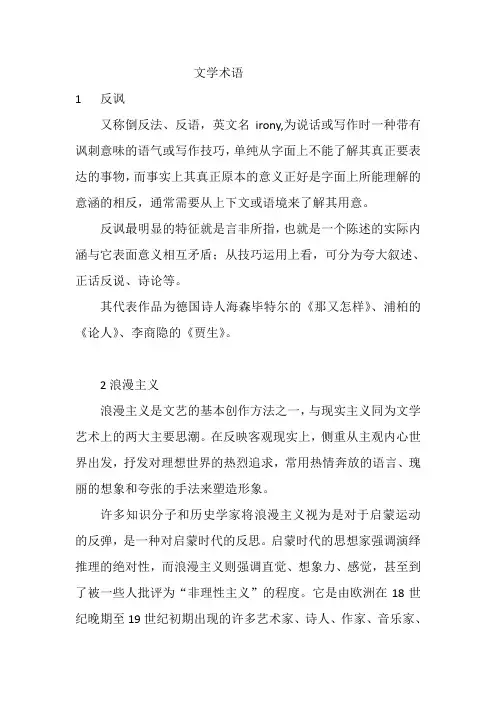
文学术语1 反讽又称倒反法、反语,英文名irony,为说话或写作时一种带有讽刺意味的语气或写作技巧,单纯从字面上不能了解其真正要表达的事物,而事实上其真正原本的意义正好是字面上所能理解的意涵的相反,通常需要从上下文或语境来了解其用意。
反讽最明显的特征就是言非所指,也就是一个陈述的实际内涵与它表面意义相互矛盾;从技巧运用上看,可分为夸大叙述、正话反说、诗论等。
其代表作品为德国诗人海森毕特尔的《那又怎样》、浦柏的《论人》、李商隐的《贾生》。
2浪漫主义浪漫主义是文艺的基本创作方法之一,与现实主义同为文学艺术上的两大主要思潮。
在反映客观现实上,侧重从主观内心世界出发,抒发对理想世界的热烈追求,常用热情奔放的语言、瑰丽的想象和夸张的手法来塑造形象。
许多知识分子和历史学家将浪漫主义视为是对于启蒙运动的反弹,是一种对启蒙时代的反思。
启蒙时代的思想家强调演绎推理的绝对性,而浪漫主义则强调直觉、想象力、感觉,甚至到了被一些人批评为“非理性主义”的程度。
它是由欧洲在18世纪晚期至19世纪初期出现的许多艺术家、诗人、作家、音乐家、以及政治家、哲学家等各种人物组成,其详细特征和定义一直到20世纪都仍是思想史和文学史界争议的题材。
其特征主要有:1 偏重于表现主观理想,抒发强烈的个人感情;2 描写自然风光,歌颂大自然;3 酷爱描写中世纪和以往的历史;4 重视民间文学,尤其是中世纪民间文学。
其代表是布莱克、华兹华斯《抒情歌妖姬》、科勒律治、拜伦、雪莱《西风颂》、普希金、贝多芬《第五交响曲》、肖邦、雨果《悲惨世界》、欧文《睡谷传说》、麦尔维尔《白鲸》、司格特《艾凡赫》、屈原《离骚》、李白《将进酒》、郭沫若3 清教主义清教主义起源于英国,在北美得以实践和发展。
其因信称义、天职思想、山巅之城等核心理念虽然构成宗教行为规范要素,却在很大程度上起到了消解禁锢人们思想和行为的主流教会传统的作用,促进了社会世俗化进程。
在早期的美国,推动力个性解放,促成建立现代劳动、职业和财富观,以宗教的理想勾勒出国家未来追求的目标。
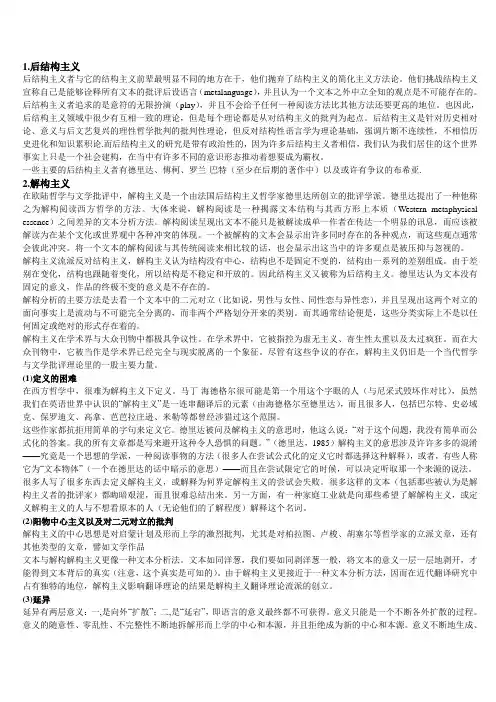
1.后结构主义后结构主义者与它的结构主义前辈最明显不同的地方在于,他们抛弃了结构主义的简化主义方法论。
他们挑战结构主义宣称自己是能够诠释所有文本的批评后设语言(metalanguage),并且认为一个文本之外中立全知的观点是不可能存在的。
后结构主义者追求的是意符的无限扮演(play),并且不会给予任何一种阅读方法比其他方法还要更高的地位。
也因此,后结构主义领域中很少有互相一致的理论,但是每个理论都是从对结构主义的批判为起点。
后结构主义是针对历史相对论、意义与后文艺复兴的理性哲学批判的批判性理论,但反对结构性语言学为理论基础,强调片断不连续性,不相信历史进化和知识累积论.而后结构主义的研究是带有政治性的,因为许多后结构主义者相信,我们认为我们居住的这个世界事实上只是一个社会建构,在当中有许多不同的意识形态推动着想要成为霸权。
一些主要的后结构主义者有德里达、傅柯、罗兰·巴特(至少在后期的著作中)以及或许有争议的布希亚.2.解构主义在欧陆哲学与文学批评中,解构主义是一个由法国后结构主义哲学家德里达所创立的批评学派。
德里达提出了一种他称之为解构阅读西方哲学的方法。
大体来说,解构阅读是一种揭露文本结构与其西方形上本质(Western metaphysical essence)之间差异的文本分析方法。
解构阅读呈现出文本不能只是被解读成单一作者在传达一个明显的讯息,而应该被解读为在某个文化或世界观中各种冲突的体现。
一个被解构的文本会显示出许多同时存在的各种观点,而这些观点通常会彼此冲突。
将一个文本的解构阅读与其传统阅读来相比较的话,也会显示出这当中的许多观点是被压抑与忽视的。
解构主义流派反对结构主义,解构主义认为结构没有中心,结构也不是固定不变的,结构由一系列的差别组成。
由于差别在变化,结构也跟随着变化,所以结构是不稳定和开放的。
因此结构主义又被称为后结构主义。
德里达认为文本没有固定的意义,作品的终极不变的意义是不存在的。
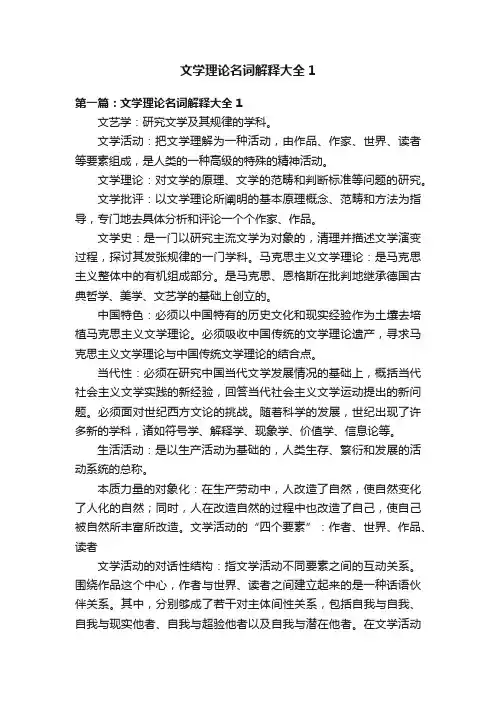
文学理论名词解释大全1第一篇:文学理论名词解释大全1文艺学:研究文学及其规律的学科。
文学活动:把文学理解为一种活动,由作品、作家、世界、读者等要素组成,是人类的一种高级的特殊的精神活动。
文学理论:对文学的原理、文学的范畴和判断标准等问题的研究。
文学批评:以文学理论所阐明的基本原理概念、范畴和方法为指导,专门地去具体分析和评论一个个作家、作品。
文学史:是一门以研究主流文学为对象的,清理并描述文学演变过程,探讨其发张规律的一门学科。
马克思主义文学理论:是马克思主义整体中的有机组成部分。
是马克思、恩格斯在批判地继承德国古典哲学、美学、文艺学的基础上创立的。
中国特色:必须以中国特有的历史文化和现实经验作为土壤去培植马克思主义文学理论。
必须吸收中国传统的文学理论遗产,寻求马克思主义文学理论与中国传统文学理论的结合点。
当代性:必须在研究中国当代文学发展情况的基础上,概括当代社会主义文学实践的新经验,回答当代社会主义文学运动提出的新问题。
必须面对世纪西方文论的挑战。
随着科学的发展,世纪出现了许多新的学科,诸如符号学、解释学、现象学、价值学、信息论等。
生活活动:是以生产活动为基础的,人类生存、繁衍和发展的活动系统的总称。
本质力量的对象化:在生产劳动中,人改造了自然,使自然变化了人化的自然;同时,人在改造自然的过程中也改造了自己,使自己被自然所丰富所改造。
文学活动的“四个要素”:作者、世界、作品、读者文学活动的对话性结构:指文学活动不同要素之间的互动关系。
围绕作品这个中心,作者与世界、读者之间建立起来的是一种话语伙伴关系。
其中,分别够成了若干对主体间性关系,包括自我与自我、自我与现实他者、自我与超验他者以及自我与潜在他者。
在文学活动中,主体和对象的关系始终处于发展与变化之中。
一方面是主体的对象化,另一方面是对象的主体化,正是在主体对象化和对象主体化的互动过程中,才生动地显示出了文学所特有的社会的和审美的本质属性。
文学专业术语Literary Terms1. Literature of the absurd: (荒诞派文学) The term is applied to a number of works in drama and prose fiction which have in common the sense that the human condition is essentially absurd, and that this condition can be adequately represented only in works of literature that are themselves absurd. The current movement emerged in France after the Second World War, as a rebellion against essential beliefs and values of traditional culture and traditional literature. They hold the belief that a human being is an isolated existent who is cast into an alien universe and the human life in its fruitless search for purpose and meaning is both anguish and absurd.2. Theater of the absurd: (荒诞派戏剧) belongs to literature of the absurd. Two representatives of this school are Eugene Ionesco, French author of The Bald Soprano (1949) (此作品中文译名<秃头歌女>), and Samuel Beckett, Irish author of Waiting for Godot (1954) (此作品是荒诞派戏剧代表作<等待戈多>). They project the irrationalism, helplessness and absurdity of life in dramatic forms that reject realistic settings, logical reasoning, or a coherently evolving plot.3. Black comedy or black humor: (黑色幽默) it mostly employed to describe baleful, naïve, or inept characters in a fantastic or nightmarish modern world playing out their roles in what Ionesco called a “tragic farce”, in which the events are often simultaneously comic, horrifying, and absurd. Joseph Heller’s Catch-22 (美国著名作家约瑟夫海勒<二十二条军规>) can be taken as an example of the employment of this technique.4. Aestheticism or the Aesthetic Movement(唯美主义): it began to prevail in Europe at the middle of the 19th century. The theory of “art for art’s sake” was first put forward by some French artists. They declared that art should serve no religious, moral or social purpose. The two most important representatives of aestheticists in English literature are Walt Pater and Oscar Wilde.5. Allegory(寓言): a tale in verse or prose in which characters, actions, or settings represent abstract ideas or moral qualities, such as John Buny an’s The Pilgrim’s Progress. An allegory is a story with two meanings, a literal meaning and a symbolic meaning.6. Fable(寓言): is a short narrative, in prose or verse, that exemplifies an abstract moral thesis or principle of human behavior. Most common is the beast fable, in which animals talk and act like the human types they represent. The fables in Western cultures derive mainly from the stories attributed to Aesop, a Greek slave of the sixth century B. C.7. Parable(寓言): is a very short narrative about human beings presented so as to stress analogy witha general lesson that the narrator is trying to bring home to his audience. For example, the Bible contains lots of parables employed by Jesus Christ to make his flock understand his preach.(注意以上三个词在汉语中都翻译成语言,但是内涵并不相同,不要搞混)8. Alliteration(头韵): the repetition of the initial consonant sounds. In Old English alliterative meter, alliteration is the principal organizing device of the verse line, such as in Beowulf.9. Consonance is the repetition of a sequence of two or more consonants but with a change in the intervening vowel, such as “live and love”.10. Assonance is the repetition of identical or similar vowel, especially in stressed syllables, in a sequence of nearby words, such as “child of silence”.11. Allusion (典故)is a reference without explicit identification, to a literary or historical person, place, or event, or to another literary work or passage. Most literary allusions are intended to be recognized by the generally educated readers of the author’s time, but some are aimed at a special group.12. Ambiguity(复义性): Since William Empson(燕卜荪)published Seven Types of Ambiguity (《复义七型》), the term has been widely used in criticism to identify a deliberate poetic device: the use of a single word or expression to signify two or more distinct references, or to express two or more diverse attitudes or feeling.13. Antihero(反英雄):the chief character in a modern novel or play whose character is totally different from the traditional heroes. Instead of manifesting largeness, dignity, power, or heroism, the antihero is petty, passive, ineffectual or dishonest. For example, the heroine of Defoe’s Moll Flanders is a thief and a prostitute.14. Antithesis(对照):(a figure of speech) An antithesis is often expressed in a balanced sentence, that is, a sentence in which identical or similar syntactic structure is used to express contrasting ideas. For example, “Marriage has many pains, but celibacy(独身生活)has no pleasures.” by Samuel Johnson obviously employs antithesis.15. Archaism(拟古):the literary use of words and expressions that have become obsolete in the common speech of an era. For example, the translators of the King James Version of Bible gave weight and dignity to their prose by employing archaism.16. Atmosphere(氛围): the prevailing mood or feeling of a literary work. Atmosphere is often developed, at least in part, through descriptions of setting. Such descriptions help to create an emotional climate to establish the reader’s expectations and attitudes.17. Ballad(民谣):it is a song, transmitted orally, which tells a story. It originated and was communicated orally among illiterate or only partly literate people. It exists in many variant forms. The most common stanza form, called ballad stanza is a quatrain in alternate four- and three-stress lines; usually only the second and fourth lines rhyme. Although many traditional ballads probably originated in the late Middle Age, they were not collected and printed until the eighteenth century. 18. Climax:as a rhetorical device it means an ascending sequence of importance. As a literary term, it can also refer to the point of greatest intensity, interest, or suspense in a story’s turning point. The action leading to the climax and the simultaneous increase of tension in the plot are known as the rising action. All action after the climax is referred to as the falling action, or resolution. The term crisis is sometimes used interchangeably with climax.19. Anticlimax(突降):it denotes a writer’s deliberate drop from the ser ious and elevated to the trivial and lowly, in order to achieve a comic or satiric effect. It is a rhetorical device in English.20. Beat Generation(垮掉一代):it refers to a loose-knit group of poets and novelists, writing in the second half of the 1950s and early 1960s, who shared a set of social attitudes –antiestablishment, antipolitical, anti-intellectual, opposed to the prevailing cultural, literary, and moral values, and in favor of unfettered self-realization and self-expression. Representatives of the group include Allen Ginsberg, Jack Kerouac and William Burroughs. And most famous literary creations produced by this group should be Allen Ginsberg’s long poem Howl and Jack Kerouac’s On the Road.21. Biography(传记):a detailed account of a person’s life w ritten by another person, such as Samuel Johnson’s Lives of the English Poets and James Boswell’s Life of Samuel Johnson.22. Autobiography(自传):a person’s account of his or her own life, such as Benjamin Franklin’s autobiography.23. Blank verse(无韵诗):it consists of lines of iambic pentameter which are unrhymed. Of all English metrical forms it is closest to the natural rhythms of English speech, and at the same time flexible and adaptive to diverse levels of discourse; as a result it has been more frequently and variously used than any other type of versification. Soon after blank verse was introduced by the Earl of Surrey in his translation of Virgil’s works, it became the standard meter for Elizabethan and later poetic dramas and some poets also employed this form to write their long poems such as John Milton’s Paradise Lost.24. A parody(模仿)imitates the serious manner and characteristic features of a particular literary work, or the distinctive style of a particular author, or the typical stylistic and other features of aserious literary genre, and deflates the original by applying the imitation to a lowly or comically inappropriate subject.25. Celtic Revival also known as the Irish Literary Renaissance (爱尔兰文艺复兴)identifies the remarkably creative period in Irish literature from about 1880 to the death of William Butler Yeats in 1939. The aim of Yeats and other early leaders of the movement was to create a distinctively national literature by going back to Irish history, legend, and folklore, as well as to native literary models. The major writers of this movement include William Butler Yeats, Lady Gregory, John Millington Synge and Sean O’Casey and so on.26. Characters(人物)are the persons represented in a dramatic or narrative work, who are interpreted by the reader as being endowed with particular moral, intellectual, and emotional qualities by inferences from the dialogues, actions and motivations. E. M. Forster divides characters into two types: flat character, which is presented without much individualizing detail; and round character, which is complex in temperament and motivation and is represented with subtle particularity.27. Chivalric Romance (or medieval romance) (骑士传奇或中世纪传奇)is a type of narrative that developed in twelfth-century France, spread to the literatures of other countries. Its standard plot is that of a quest undertaken by a single knight in order to gain a lady’s favor; frequently its central interest is courtly love, together with tournaments fought and dragons and monsters slain. It stresses the chivalric ideals of courage, loyalty, honor, mercifulness to an opponent, and elaborate manners. 28. Comedy:(喜剧)in general, a literary work that ends happily with a healthy, amicable armistice between the protagonist and society.29. Farce (闹剧)is a type of comedy designed to provoke the audience to simple and hearty laughter. To do so it commonly employs highly exaggerated types of characters and puts them into improbable and ludicrous situations.30. Confessional poetry(自白派诗歌)designates a type of narrative and lyric verse, given impetus by Robert Lowell’s Life Studies, which deals with the facts and intimate mental and physical experiences of the poet’s own life. Confessional poetry was written in rebellion against the demand for impersonality by T. S. Elliot and the New Criticism. The representative writers of confessional school include Robert Lowell, Anne Sexton and Sylvia Plath and so on.31. Critical Realism:(批判现实主义)The critical realism of the 19th century flourished in the fouties and in the beginning of fifties. The realists first and foremost set themselves the task of criticizing capitalist society from a democratic viewpoint and delineated the crying contradictions of bourgeoisreality. But they did not find a way to eradicate social evils. Representative writers of this trend include Charles Dickens and William Makepeace Thackeray and so on.32. Drama: (戏剧)The form of composition designed for performance in the theater, in which actors take the roles of the characters, perform the indicated action, and utter the written dialogue. (The common alternative name for a dramatic composition is a play.)33. Dramatic Monologue:(戏剧独白)a monologue is a lengthy speech by a single person. Dramatic monologue does not designate a component in a play, but a type of lyric poem that was perfected by Robert Browning. By using dramatic monologue, a single person, who is patently not the poet, utters the speech that makes up the whole of the poem, in a specific situation at a critical moment. For example, Robert Browning’s famous poem “My Last Duchess” was written in dramatic monologue. 34. Elegy(哀歌或挽歌):a poem of mourning, usually over the death of an individual. An elegy is a type of lyric poem, usually formal in language and structure, and solemn or even melancholy in tone.35. Enlightenment(启蒙运动):The name applied to an intellectual movement which developed in Western Europe during the seventeenth century and reached its height in the eighteenth. The common element was a trust in human reason as adequate to solve the crucial problems and to establish the essential norms in life, together with the belief that the application of reason was rapidly dissipating the remaining feudal traditions. It influenced lots of famous English writers especially those neoclassic writers, such as Alexander Pope.36. Epic(史诗):it is a long verse narrative on a serious subject, told in a formal and elevated style, and centered on a heroic or quasi-divine figure on whose actions depends the fate of a tribe, a nation, or the human race.37. Epiphany:(顿悟)In the early draft of A Portrait of the Artist as a Young Man, James Joyce employed this term to signify a sudden sense of radiance and revelation that one may feel while perceiving a commonplace object. “Epiphany” now has become th e standard term for the description, frequent in modern poetry and prose fiction, of the sudden flare into revelation of an ordinary object or scene.38. Epithet: as a term in criticism, epithet denotes an adjective or adjectival phrase used to define a distinctive quality of a person or thing. This method was widely employed in ancient epics. For example, in Homer’s epic, the epithet like “the wine-dark sea” can be found everywhere.39. Essay:(散文)any short composition in prose that undertakes to discuss a matter, express a point of view, persuade us to accept a thesis on any subject, or simply entertain. The essay can be divided asthe formal essay and the informal essay (familiar essay).40. Euphemism(委婉语): An inoffensive expression used in place of a blunt one that is felt to be disagreeable or embarrassing, such as “pass away” instead of “die”41. Expressionism(表现主义):a German movement in literature and the other arts which was at its height between 1910 and 1925 –that is, in the period just before, during, and after WWⅠ. The expressionist artist or writer undertakes to express a personal vision – usually a troubled or tensely emotional vision – of human life and human society. This is done by exaggerating and distorting. We recognize its effects, direct or indirect, on the writing and staging of such plays as Arthur Miller’s Death of a Salesman as well as on the theater of the absurd.42. Free verse(自由体诗):Like traditional verse, it is printed in short lines instead of with the continuity of prose, but it differs from such verse by the fact that its rhythmic pattern is not organized into a regular metrical form – that is, into feet, or recurrent units of weak and strong stressed syllables. Most free verse also has irregular line lengths, and either lacks rhyme or else uses it only occasionally. Walt Whitman is a representative who employed this poem form successfully.43. Gothic novel:(哥特式小说)It is a type of prose fiction. The writers of this type of fictions mostly set their stories in the medieval period and in a Catholic country, especially Italy or Spain. The locale was often a gloomy castle. The typical story focused on the sufferings imposed on an innocent heroine by a cruel villain. This type of fictions made bountiful use of ghosts, mysterious disappearances, and other supernatural occurrences. The principle aim of such novels was to evoke chilling terror and the best of this type opened up to the fiction the realm of the irrational and of the perverse impulses and nightmarish terrors that lie beneath the orderly surface of the civilized mind. Some famous novelists liked to employ some Gothic elements in their novels, such as Emily Bronte’s Wuthering Heights. 44. Graveyard poets(墓园派诗歌): A term applied to eighteenth-century poets who wrote meditative poems, usually set in a graveyard, on the theme of human mortality, in moods which range from pensiveness to profound gloom. The vogue resulted in one of the most widely known English poems, Thomas Gray’s “Elegy Written in a Country Churchyard”.45. Harlem Renaissance(哈莱姆文艺复兴):a period of remarkable creativity in literature, music, dance, painting, and sculpture by African-Americans, from the end of the First World War in 1917 through the 1920s. As a result of the mass migrations to the urban North in order to escape the legal segregation of the American South, and also in order to take advantage of the jobs opened to African Americans at the beginning of the War, the population of the region of Manhattan known as Harlembecame almost exclusively Black, and the vital center of African American culture in America. Distinguished writers who were part of the movement included Langston Hughes and Jean Toomer. The Great Depression of 1929 and the early 1930s brought the period of buoyant Harlem culture –which had been fostered by prosperity in the publishing industry and the art world – effectively to an end.46. Heroic Couplet(英雄双韵体)refers to lines of iambic pentameter which rhyme in pairs: aa, bb, cc, and so on. The adjective “heroic” was applied in the later seven teenth century because of the frequent use of such couplets in heroic poems and dramas. This verse form was introduced into English poetry by Geoffrey Chaucer. From the age of John Dryden through that of Samuel Johnson, the heroic couplet was the predominant English measure for all the poetic kinds; some poets, including Alexander Pope, used it almost to the exclusion of other meters.47. Hyperbole(夸张):this figure of speech called hyperbole is bold overstatement, or the extravagant exaggeration of fact or of possibility. It may be used either for serious or ironic or comic effect.48. Understatement(轻描淡写):this figure of speech deliberately represents something as very much less in magnitude or importance than it really is, or is ordinarily considered to be. The effect is usually ironic.49. Imagism(意象派):it was a poetic vogue that flourished in England, and even more vigorously in America, between the years 1912 and 1917. It was planned and exemplified by a group of English and American writers in London, partly under the influence of the poetic theory of T. E. Hulme, as a revolt against the sentimental and mannerish poetry at the turn of the century. The typical Imagist poetry is written in free verse and undertakes to be as precisely and tersely as possible. Meanwhile, the Imagist poetry likes to express the writers’ momentary impression of a visual object or scene and often the impression is rendered by means of metaphor without indicating a relation. Most famous Imagist poem, “In a Station of the Metro”, wa s written by Ezra Pound. Imagism was too restrictive to endure long as a concerted movement, but it influenced almost all modern poets of Britain and America. 50. Irony(反讽):This term derives from a character in a Greek comedy. In most of the modern critical uses of the term “irony”, there remains the root sense of dissembling or hiding what is actually the case; not, however, in order to deceive, but to achieve rhetorical or artistic effects.51. Local Colorism(地方色彩)was a literary trend belonging to Realism. It refers to the detailed representation in prose fiction of the setting, dialect, customs, dress and ways of thinking and feeling which are distinctive of a particular region. After the Civil War a number of American writersexploited the literary possibilities of local color in various parts of America. The most famous representative of local colorism should be Mark Twain who took his hometown near the Mississippi as the typical setting of nearly all his novels.52. Lyric(抒情诗):in the most common use of the term, a lyric is any fairly short poems consisting of the utterance by a single speaker, who expresses a state of mind or a process of perception, thought and feeling.53. Metaphysical Poets(玄学派诗人):The name is now applied to a group of seventeenth-century poets who, whether or not directly influenced by John Donne, employ similar poetic procedures and imagery, both in secular poetry and in religious poetry. Metaphysical poetry is characterized by irregular meter, colloquial language and original images.54. Modernism(现代主义):The term modernism is widely used to identify new and distinctive features in the subjects, forms, concepts, and styles of literature and the other arts in the early decades of the 20th century, but especially after WWI. The specific features signified by “modernism” vary with the user, but many critics agree that it involves a deliberate and radical break with some of the traditional bases not only of Western art, but of Western culture in general.55.Postmodernism(后现代主义):The term postmodernism is often applied to the literature and art after WWII. Postmodernism involves not only a continuation, sometimes carried to an extreme, of the countertraditional experiments of modernism, but also diverse attempts to break away from modernist forms which had, inevitably, become in their turn conventional, as well as to overthrow the elitism of modernist “high art” by recourse to the models of “mass art”.56. Theme(主题):The term is usually applied to a general concept or doctrine, whether implicit or asserted, which an imaginative work is designed to incorporate and make persuasive to the reader. 57. Multiple Point of View (多重视角):It is one of the literary techniques William Faulkner used, which shows within the same story how the characters reacted differently to the same person or the same situation. The use of this technique gave the story a circular form wherein one event was the center, with various points of view radiating from it. The multiple points of view technique makes the reader recognize the difficulty of arriving at a true judgment.58. Ode(颂诗):An ode is a complex and often lengthy lyric poem, written in a dignified formal style on some lofty or serious subject.59. Magic realism(魔幻现实主义)is a new literary genre appeared in the 20th century. The writers, who employed magic realistic techniques, interweave, in an ever-lasting pattern, a sharply etchedrealism in representing ordinary events and descriptive details together with fantastic and dreamlike elements, as well as with materials derived from myth and fairy tales. In American literature, some of Toni Morrison’s novels employed magic realistic elements.60. Transcendentalism(超验主义):appeared in 1830s in US;emphasis on spirit or oversoul and stressing importance of the individual;regarding nature as symbols of the spirit or God and emphasis on brotherhood of man;representatives: Ralph Waldo Emerson and Henry David Thoreau61. Lost Generation(迷惘的一代):Many prominent American writers of the decade following the end of WWI, disillusioned by their war experience and alienated by what they perceived as the crassness of American culture are often tagged as Lost Generation. Their representatives are F. Scott Fitzgerald and Ernest Hemingway.62. Naturalism(自然主义):Naturalism was a new and harsher realism. Naturalists dismissed the validity of comforting moral truths. They attempted to achieve extreme objectivity and frankness, presenting characters of low social and economic classes who were determined by their environment and heredity. In presenting the extremes of life, the naturalists sometimes displayed an affinity to the sensationalism of early romanticism, but unlike their romantic predecessors, the naturalists emphasized that the world was amoral, that men and women had no free will, that lives were controlled by heredity and environment, that the destiny of humanity was misery in life and oblivion in death. In American literature, Theodore Dreiser is a representative of naturalism.63. American Puritanism(清教主义):Puritanism is the practices and beliefs of the Puritans. The Puritans were originally members of a division of the Protestant Church. They were a group of serious, religious people, advocating highly religious and moral principles. As the word itself hints, Puritans wanted to purity their religious beliefs and practices. They accepted the doctrine of predestination, original sin and total depravity, and limited atonement through a special infusion of grace form God. As a culture heritage, Puritanism did have a profound influence on the early American mind. American Puritanism also had an enduring influence on American literature.64. Flashback(闪回):interpolating narratives or scenes which represent events that happened before the time at which the work opened; for example, it is used in Arthu r Miller’s Death of a Salesman. 65. Plot(情节):The plot in a dramatic or narrative work is constituted by its events and actions, as these are rendered and ordered toward achieving particular artistic and emotional effects.。
狭义文学名词解释
狭义的文学术语是指文学中的专有术语,这些术语是作家、文学学者和文学评论家用来描述文学作品的特定元素和技术的。
以下是一些常见的狭义文学术语的解释。
1. 韵律:韵律是一个诗歌的音韵特点,指的是诗歌中的韵脚、韵母、音调和音量。
2. 押韵:押韵是指两个或多个单词的结尾音相同,它是诗歌中的一个最基本的韵律技巧。
3. 格律:格律是指诗歌的一种格式,包括诗行、押韵和韵律规则。
4. 暗示:暗示是指在文学作品中使用意味深长的言辞来传达特定的信息或概念。
5. 比喻:比喻是一种修辞手法,将一个事物与另一个不同的事物进行对比,以便更好地描述和理解。
6. 拟人:拟人是一种修辞手法,用人类的属性和行为来描述非人类的事物或抽象概念。
7. 叙述:叙述是指讲述故事中的事件和情节的方式,可以是第一人称或第三人称。
8. 描述:描述是指以多种方式来描绘人物、地点、情景和事物的外观和感官体验。
9. 对话:对话是指在文学作品中使用字符之间的交谈和交流的过程,可以用来展示角色的性格和关系。
10. 主题:主题是文学作品中表达的基本思想、信念或道德观点,通常贯穿整个作品。
这些狭义文学术语在文学中非常常见,对于读者和学者来说,理解这些概念对于分析和欣赏文学作品是至关重要的。
1、知我者,谓我心忧,不知我者,谓我何求。
(诗经王风黍离)2、人而无仪,不死何为。
(诗经风相鼠)3、言者无罪,闻者足戒。
(诗经大序)4、他山之石,可以攻玉。
(诗经小雅鹤鸣)5、投我以桃,报之以李。
(诗经大雅抑)6、天作孽,犹可违,自作孽,不可活。
(尚书)7、满招损,谦受益。
(尚书大禹谟)8、从善如登,从恶如崩。
(国语)9、多行不义必自毙。
(左传)10、居安思危,思则有备,有备无患。
(左传)11、人非圣贤,孰能无过?过而能改,善莫大焉。
(左传)12、知人者智,自知者明。
(老子)13、信言不美,美言不信。
(老子)14、祸兮福之所倚,福兮祸之所伏。
(老子)15、合抱之木,生于毫末;九层之台,起于累土;千里之行,始于足下。
(老子)16、敏而好学,不耻下问。
(论语公冶长)17、己所不欲,勿施于人。
(论语颜渊)18、工欲善其事,必先利其器。
(论语卫灵公)19、君子坦荡荡,小人长戚戚。
(论语述而)20、岁寒,然后知松柏之后凋也。
(论语子罕)21、学而不思则罔,思而不学则殆。
(论语为政)22、知者不惑,仁者不忧,勇者不惧。
(论语子罕)23、人谁无过?过而能改,善莫大焉。
(论语)24、知之为知之,不知为不知,是知也。
(论语为政)25、知之者不如好之者,好之者不如乐之者。
(论语雍也)26、其身正,不令而行;其身不正,虽令不从。
(论语子路)27、三人行,必有我师焉:择其善而从之,其不善者而改之。
(论语述而)28、大道之行,天下为公。
(礼记礼运)29、凡事预则立,不预则废。
(礼记中庸)30、学然后知不足,教然后知困。
(礼记学记)31、玉不琢,不成器;人不学,不知道。
(礼记学记)32、路漫漫其修远兮,吾将上下而求索。
(屈原离骚)33、尺有所短,寸有所长。
(楚辞卜居)34、尽信书,不如无书。
(孟子尽心下)35、生于忧患,死于安乐。
(孟子告子下)36、得道多助,失道寡助。
(孟子公孙丑)37、民为贵,社稷次之,君为轻。
(孟子尽心上)38、穷则独善其身,达则兼济天下。
汉文文学领域术语
1. 小说:一种长篇故事性文学作品,通常由多个章节组成。
2. 散文:不受诗歌形式限制的散文性文学作品。
3. 诗歌:用韵律和格律进行表达的文学作品。
4. 戏剧:包括话剧、音乐剧、舞台剧等形式的戏曲表演艺术形式。
5. 长篇小说:指字数较多、情节丰富、主题深刻的小说。
6. 短篇小说:指字数较少、情节简单但精炼、主题突出的小说。
7. 叙事诗:一种通过叙述故事内容来表达思想和情感的诗歌形式。
8. 抒情诗:一种通过表达感情和情感来表达思想和主题的诗歌形式。
9. 唐诗:指唐代(公元618年至907年)时期创作的诗歌作品。
10. 宋词:指宋代(公元960年至1279年)时期创作的词作品,以抒发情感为主要特点。
文学术语汇编(考研用)11. Literature of the absurd: (荒诞派文学)2. Theater of the absurd: (荒诞派戏剧)3. Black comedy or black humor: (黑色幽默)文学术语汇编24. Aestheticism or the Aesthetic Movement(唯美主义):5. Allegory(寓言):6. Fable(寓言):7. Parable(寓言):(注意以上三个词在汉语中都翻译成语言,但是内涵并不相同,不要搞混)8. Alliteration(头韵): 9. Consonance 10. Assonance11. Allusion (典故)12. Ambiguity(复义性):文学术语汇编313. Antihero(反英雄):14. Antithesis(对照):15. Archaism(拟古):16. Atmosphere(氛围):文学术语汇编417. Ballad(民谣):18. Climax:19. Anticlimax(突降):20. Beat Generation(垮掉一代):文学术语汇编521. Biography(传记):22. Autobiography(自传):23. blank verse (无韵诗,素体诗(不押韵的五音步诗行))24. A parody(模仿)文学术语汇编625. Celtic Revival also known as the Irish Literary Renaissance (爱尔兰文艺复兴)26. Characters(人物)27. Chivalric Romance (or medieval romance) (骑士传奇或中世纪传奇)28. Comedy:(喜剧)29. Farce (闹剧)30. Confessional poetry(自白派诗歌)31. Critical Realism:(批判现实主义)32. Drama: (戏剧)文学术语汇编733. Dramatic Monologue:(戏剧独白)34. Elegy(哀歌或挽歌):35. Enlightenment(启蒙运动):36. Epic(史诗):37. Epiphany:(顿悟)38. Epithet: (绰号,诨名)39. Essay:(散文)40. Euphemism(委婉语): 41. Expressionism(表现主义):42. Free verse(自由体诗):文学术语汇编843. Gothic novel:44. Graveyard poets(墓园派诗人):45. Harlem Renaissance(哈莱姆文艺复兴):46. Heroic Couplet(英雄双韵体)47. Hyperbole(夸张):49. Imagism(意象派):50. Irony(反讽):51. Local Colorism(地方色彩)52. Lyric(抒情诗):。
文学术语汇编(考研用)11.Literature of the absurd: (荒诞派文学) The term is applied to a number of works in drama and prose fiction which have in common the sense that the human condition is essentially absurd, and that this condition can be adequately represented only in works of literature that are themselves absurd. The current movement emerged in France after the Second World War, as a rebellion against essential beliefs and values of traditional culture and traditional literature. They hold the belief that a human being is an isolated existent who is cast into an alien universe and the human life in its fruitless search for purpose and meaning is both anguish and absurd.2.Theater of the absurd: (荒诞派戏剧) belongs to literature of the absurd. Two representatives of this school are Eugene Ionesco, French author of The Bald Soprano (1949) (此作品中文译名<秃头歌女>), and Samuel Beckett, Irish author of Waiting for Godot (1954) (此作品是荒诞派戏剧代表作<等待戈多>). They project the irrationalism, helplessness and absurdity of life in dramatic forms that reject realistic settings, logical reasoning, or a coherently evolving plot.3.Black comedy or black humor: (黑色幽默) it mostly employed to describe baleful, naïve, or inept characters in a fantastic or nightmarish modern world playing out their roles in what Ionesco called a “tragic farce”, in which the events are often simultaneously comic, horrifying, and absurd. Joseph Heller’s Catch-22 (美国著名作家约瑟夫海勒<二十二条军规>) can be taken as an example of the employment of this technique.文学术语汇编24. Aestheticism or the Aesthetic Movement(唯美主义): it began to prevail in Europe at the middle of the 19th century. The theory of “art for art’s sake”was first put forward by some French artists. They declared that art should serve no religious, moral or social purpose. The two most important representatives of aestheticists in English literature are Walt Pater and Oscar Wilde.5. Allegory(寓言): a tale in verse or prose in which characters, actions, or settings represent abstract ideas or moral qualities, such as John Bunyans The Pilgrim’s Progress. An allegory is a story with two meanings, a literal meaning and a symbolic meaning.6. Fable(寓言): is a short narrative, in prose or verse, that exemplifies an abstract moral thesis or principle of human behavior. Most common is the beast fable, in which animals talk and act like the human types they represent. The fables in Western cultures derive mainly from the stories attributed to Aesop, a Greek slave of the sixth century B. C.7. Parable(寓言): is a very short narrative about human beings presented so as to stress analogy with a general lesson that the narrator is trying to bring home to his audience. For example, the Bible contains lots of parables employed by Jesus Christ to make his flock understand his preach. (注意以上三个词在汉语中都翻译成语言,但是内涵并不相同,不要搞混)8. Alliteration(头韵): the repetition of the initial consonant sounds. In Old English alliterative meter, alliteration is the principal organizing device of the verse line, such as in Beowulf.9. Consonance is the repetition of a sequence of two or more consonants but with a change in the intervening vowel, such as “live and love”.10. Assonance is the repetition of identical or similar vowel, especially in stressed syllables, in a sequence of nearby words, such as “child of silence”.11. Allusion (典故)is a reference without explicit identification, to a literary or historical person, place, or event, or to another literary work or passage. Most literary allusions are intended to be recognized by the generally educated readers of the aut hor’s time, b ut some are aimed at a special group.12. Ambiguity(复义性): Since William Empson(燕卜荪)published Seven Types of Ambiguity (《复义七型》), the term has been widely used in criticism to identify a deliberate poetic device: the use of a single word or expression to signify two or more distinct references, or to express two or more diverse attitudes or feeling.文学术语汇编313. Antihero(反英雄):the chief character in a modern novel or play whose character is totally different from the traditional heroes. Instead of manifesting largeness, dignity, power, or heroism, the antihero is petty, passive, ineffectual or dishonest. For ex ample, the heroine of Defoe’s Moll Flanders is a thief and a prostitute.14. Antithesis(对照):(a figure of speech)An antithesis is often expressed in a balanced sentence, that is, a sentence in which identical or similar syntactic structure is used to express contrasting ideas. For example, “Marriage has many pains, but celibacy(独身生活)has no pleasures.”by Samuel Johnson obviously employs antithesis.15. Archaism(拟古):The literary use of words and expressions that have become obsolete in the common speech of an era. For example, the translators of the King James Version of Bible gave weight and dignity to their prose by employing archaism.16. Atmosphere(氛围): The prevailing mood or feeling of a literary work. Atmosphere is often developed, at least in part, through descriptions of setting. Such descriptions help to create an emotional climate to establish the reader’s expectations and attitudes.文学术语汇编417. Ballad(民谣):It is a song, transmitted orally, which tells a story. It originated and was communicated orally among illiterate or only partly literate people. It exists in many variant forms. The most common stanza form, called ballad stanza is a quatrain in alternate four- and three-stress lines; usually only the second and fourth lines rhyme. Although many traditional ballads probably originated in the late Middle Age, they were not collected and printed until the eighteenth century.18. Climax:as a rhetorical device it means an ascending sequence of importance. As a literary term, it can also refer to the point of greatest intensity, interest, or suspense in a story’s turning point. The action leading to the climax and the simultaneous increase of tension in the plot are known as the rising action. All action after the climax is referred to as the falling action, or resolution. The term crisis is sometimes used interchangeably with climax.19. Anticlimax(突降):it denotes a writer’s deliberate drop from the serious and elevated to the trivial and lowly, in order to achieve a comic or satiric effect. It is a rhetorical device in English. 20. Beat Generation(垮掉一代):it refers to a loose-knit group of poets and novelists, writing in the second half of the 1950s and early 1960s, who shared a set of social attitudes –antiestablishment, antipolitical, anti-intellectual, opposed to the prevailing cultural, literary, and moral values, and in favor of unfettered self-realization and self-expression. Representatives of the group include Allen Ginsberg, Jack Kerouac and William Burroughs. And most famous literary creations produced by this group should be Allen Ginsberg’s long poem Howl and Jack Kerouac’sOn the Road.文学术语汇编521. Biography(传记):a detailed account of a person’s life written by another person, such as Samuel Johnson’s Lives of the English Poets and James Boswell’s Life of Samuel Johnson.22. Autobiography(自传):a person’s account of his or her own life, such as Benjamin Franklin’s autobiography.24. A parody(模仿)imitates the serious manner and characteristic features of a particular literary work, or the distinctive style of a particular author, or the typical stylistic and other features of a serious literary genre, and deflates the original by applying the imitation to a lowly or comically inappropriate subject.第23个应该是blank verse但系统总说含有不允许的关键字,所以一直发不上来,很郁闷,我把目前编好的一起发到公开邮箱去,大家到那里下载。
文学术语1、Romance: It is a narrative verse of prose singing knightly adventures or other heroic deeds. Romances are popular in the medieval period.2Ballad: :A story told in song, usually in four line stanzas, with the 2nd and the 4th lines rhymed.3、Renaissance--a thristing curiosity for classical literature;--a keen interest in life and human activities.4、Humanism--individualism; the joy of the present life; reason; the affirmation of self-worth--Humanism emphasizes the dignity of human beings and the importance of the present life. Humanists voiced their beliefs that man was the center of the universe and man did not only have the right to enjoy the beauty of the present life, but had the ability to perfect himself and to perform wonders.5、Sonnet: : It is a poem of 14 lines that follows a strict rhyme scheme and specific structure; it expresses a single idea or theme. (Thomas Wyatt first introduced it to England)6、Shakespearean sonnet: : A Shakespearean sonnet consists of three four-line stanzas (called quatrains) and a final couplet composed in iambic pentameter with the rhyme scheme abab cdcd efef gg.7、iambic pentameter:is a form of rhythm that appears in poetry, songs, and some prose compositions. It is most closely associated with poetry, especially English poetry, which lends itself very well to this particular form of rhythm8、Blank verse: having a regular meter, but no rhyme. (Henry Howard, Earl of Surrey)9、Spenserian stanza斯宾塞诗体: : Each stanza contains nine lines in total: eight lines in iambic pentameter followed by a single 'Alexandrine' line in iambic hexameter. The rhyme scheme of these lines is "ababbcbcc."10、--Sonnet 18 by Shakespeare (“Shall I Compare Thee to a Summer’s Day”): time, mortality, immortality11、Cavalier poets骑士诗人: --Reflected the royalist values;--Themes: beauty, love, loyalty, morality;--Style: Direct, short, frankly erotic--Motto: “Carpe Diem”“Seize the Day”12、Metaphysical school:玄学派--the founder of the Metaphysical school: John Donne--conceit: an extended metahpor involving dramatic contrasts or far-fetched comparisons;13、Enlightenment启蒙运动--an intellectual movement in Europe in the 18th century;--Reason as the guiding principle for thinking and action;--the belief in eternal truth, eternal justice, natural equality ;--a continuation of Renaissance; (Belief in the possibility of human perfection through education).14、Neo-classicism:新古典主义--A revival of classical standards of order, harmony, balance, simplicity and restrained emotion in literature in the 18th century.15、Sentimentalism--the middle and later decades of the 18th c.;--definition: passionover reason, personal instincts over social duties; the return of the patriarchal times; lamenting over the destructive effects of industrialization16、The Graveyard School---refers to a group of primarily 18th Century poets and writers, mostly male.whose frequently touched on themes of death, mortality, religion, and melancholy. Often elegiac in tone (and title) — an elegy is, by the 18th Century, simply a poem in lament of a death — these poems make frequent use of funereal or gloomy imagery, though their purpose was rarely sensationalist. . 17、Romanticism:--Features: individual as the center of all life and experience; from the outer world to the inner world; Passion; imagination ; Nature; pastoral; past ; Individual freedom; simple and spontaneous expression; symbolic presentations; fantastic elements;18、--Byronic Hero: an idealised but flawed anti-hero created by Byron; love of freedom, hatred of tyranny, passionate, rebellious, chivalrous, arrogant, cynical, individualistic, isolated, single-handedly, melancholy19、Female Gothic refers to the tradition of Gothic writing by women . . . that represents the female experience within domesticity as one of imprisonment, claustrophobia and terror.20、Naturalism: Heredity and social environment as the shaping forces of one’s character; to determine "scientifically" the underlying forces influencing the actions of the characters. pessimism; fatalism; detached perspective;21、Modernism:--1/theorytical basis---irrational philosophy,theory of psychoanalysis.2/innovative forms--- the rejection of tradition,critique of modern culture 3/thematic concerns---concerns for inner world,the subjective and the private(the nature of human existence,loneliness,anger,sense of loss,ill relationships,spiritual crisis)22、Steam of consciousness novel:the style of writing that attempts to imitate the natural flow of a character’s thoughts, feelin gs, reflections, memories, and mental images as the character experiences them.23、Existentialism--“Existence precedes essence”--Theme;24、Symbolism:--the use of one object to represent another25、Metafiction: also known as Romantic irony in the context of Romantic works of literature, uses literary techniques to draw attention to itself as a work of art, while exposing the "truth" of a story. "Metafiction" is the literary term describing fictional writing that self-consciously and systematically draws attention to its status as an artifact in posing questions about the relationship between fiction and reality, usually using irony and self-reflection.26、Theatre of the Absurd;is a designation for particular plays of absurdistfiction written by a number of primarily European playwrights in the late 1950s, as well as one for the style of theatre which has evolved from their work. Their work expressed the belief that human existence has no meaning or purpose and therefore all communication breaks down. Logical construction and argument gives way to irrational and illogical speech and to its ultimate conclusion, silence。